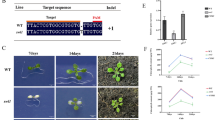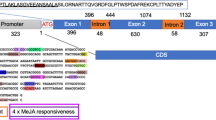Abstract
Tomato yellow leaf curl virus (TYLCV) is a begomovirus infecting tomato plants worldwide. TYLCV needs a healthy host environment to ensure a successful infection cycle for long periods. Hence, TYLCV restrains its destructive effect and induces neither a hypersensitive response nor cell death in infected tomatoes. On the contrary, TYLCV counteracts cell death induced by other factors, such as inactivation of HSP90 functionality. Suppression of plant death is associated with the inhibition of the ubiquitin 26S proteasome degradation and with a deactivation of the heat shock transcription factor HSFA2 pathways (including decreased HSP17 levels). The goal of the current study was to find if the individual TYLCV genes were capable of suppressing HSP90-dependent death and HSFA2 deactivation. The expression of C2 (C3 and CP to a lesser extent) caused a decrease in the severity of death phenotypes, while the expression of V2 (C1 and C4 to a lesser extent) strengthened cell death. However, C2 or V2 markedly affected stress response under conditions of viral infection. The downregulation of HSFA2 signaling, initiated by the expression of C1 and V2, was detected in the absence of virus infection, but was enhanced in infected plants, while CP and C4 mitigated HSFA2 levels only in the infected tomatoes. The dependence of analyzed plant stress response suppression on the interaction of the expressed genes with the environment created by the whole virus infection was more pronounced than on the expression of individual TYLCV genes.




Similar content being viewed by others
References
Agarwal M (2002) PhD thesis
Amin I, Patil BL, Briddon RW, Mansoor S, Fauquet CM (2011) Comparison of phenotypes produced in response to transient expression of genes encoded by four distinct begomoviruses in Nicotiana Benthamiana and their correlation with the levels of developmental miRNAs. J Virol 8:238–244
Anfoka G, Moshe A, Fridman L, Amrani L, Rotem O, Kolot M, Zeidan M, Czosnek H, Gorovits R (2016) Tomato yellow leaf curl virus infection mitigates the heat stress response of plants grown at high temperatures. Sci Rep 6:19715. doi:10.1038/srep19715
Collins PL, Hightower LE (1982) Newcastle disease virus stimulates the cellular accumulation of stress (heat shock) mRNAs and proteins. J Virol 44:703–707
Díaz-Pendón M, Cañizares C, Moriones E, Bejarano ER, Czosnek H, Navas-Castillo J (2010) Tomato yellow leaf curl viruses: ménage à trois between the virus complex, the plant, and the whitefly vector. Mol Plant Pathol 11:441–450
Dong X, van Wezel R, Stanley J, Hong Y (2003) Functional characterization of the nuclear localization signal for a suppressor of posttranscriptional gene silencing. J Virol 77:7026–7033. doi:10.1128/JVI.77.12.7026-7033
Garrido-Ramirez ER, Sudarshana MR, Lucas WJ, Gilbertson RL (2000) Bean dwarf mosaic virus BV1 protein is a determinant of the hypersensitive response and avirulence in Phaseolus vulgaris. Mol Plant-Microbe Interact 13:1184–1194
Ghanim M, Czosnek H (2016) Interactions between the Whitefly Bemisia tabaci and Begomoviruses: biological and genomic perspectives. In: Czosnek H and Ghanim M (eds.) “Management of insect pests to agriculture: lessons learned from deciphering their genome, transcriptome and proteome” Springer
Gorovits R, Czosnek H (2007) Biotic and abiotic stress responses in breeding tomato lines resistant and susceptible to Tomato yellow leaf curl virus. In: Czosnek H (ed) Tomato yellow leaf curl virus disease: management, molecular biology and breeding for resistance. Springer, Dordrecht, pp 223–237
Gorovits R, Akad F, Beery H, Vidavsky F, Mahadav A, Czosnek H (2007) Expression of stress-response proteins upon whitefly-mediated inoculation of Tomato yellow leaf curl virus (TYLCV) in susceptible and resistant tomato plants. Mol Plant-Microbe Interact 20:1376–1383
Gorovits R, Moshe A, Kolot M, Sobol I, Czosnek H (2013a) Progressive aggregation of tomato yellow leaf curl virus coat protein in systemically infected tomato plants, susceptible and resistant to the virus. Virus Res 171:33–43. doi:10.1016/j.virusres.2012.09.017
Gorovits R, Moshe A, Ghanim M, Czosnek H (2013b) Recruitment of the host plant heat shock protein 70 by Tomato yellow leaf curl virus coat protein is required for virus infection. PLoS One 8(7):e70280. doi:10.1371/journal.pone.0070280
Gorovits R, Moshe A, Ghanim M, Czosnek H (2014) Degradation mechanisms of the Tomato yellow leaf curl virus coat protein following inoculation of tomato plants by the whitefly Bemisia tabaci. Pest Manag Sci 70:1632–1639
Gorovits R, Fridman L, Kolot M, Rotem O, Ghanim M, Shriki O, Czosnek H (2016) Tomato yellow leaf curl virus confronts host degradation by sheltering in small/midsized protein aggregates. Virus Res S0168-1702(15):30128–30123. doi:10.1016/j.virusres
Hanley-Bowdoin L, Bejarano ER, Robertson D, Mansoor S (2013) Geminiviruses: masters at redirecting and reprogramming plant processes. Nat Rev Microbiol 11:777–788
Heath MC (2000) Hypersensitive response-related death. Plant Mol Biol 44:321–334
Hooper PL, Hightower LE, Hooper PL (2012) Loss of stress response as a consequence of viral infection: implications for disease and therapy. Cell Stress Chaperones 17:647–655. doi:10.1007/s12192-012-0352-4
Hussain M, Mansoor S, Iram S, Fatima AN, Zafar Y (2005) The nuclear shuttle protein of tomato leaf curl New Delhi virus is a pathogenicity determinant. J Virol 79:4434–4439
Hussain M, Mansoor S, Iram S, Zafar Y, Briddon RW (2007) The hypersensitive response to Tomato leaf curl New Delhi virus nuclear shuttle protein is inhibited by transcriptional activator protein. Mol Plant-Microbe Interact 20:1581–1588
Jordan CV, Shen W, Hanley-Bowdoin LK, Robertson DN (2007) Geminivirus-induced gene silencing of the tobacco retinoblastoma-related gene results in cell death and altered development. Plant Mol Biol 65:163–175
Kabbage M, Williams B, Dickman MB (2013) Cell death control: the interplay of apoptosis and autophagy in the pathogenicity of Sclerotinia sclerotiorum. PLoS Pathog 9:e1003287
Liu Y, Schiff M, Serino G, Deng XW, Dinesh-Kumar SP (2002) Role of SCF ubiquitin-ligase and the COP9 signalosome in the N gene-mediated resistance response to tobacco mosaic virus. Plant Cell 14:1483–1496
Liu Y, Burch-Smith T, Schiff M, Feng S, Dinesh-Kumar SP (2004) Molecular chaperone Hsp90 associates with resistance protein N and its signaling proteins SGT1 and Rar1 to modulate an innate immune response in plants. J Biol Chem 279:2101–2108
Lozano-Durán R, Rosas-Díaz T, Gusmaroli G, Luna AP, Taconnat L, Deng XW, Bejarano ER (2011) Geminiviruses subvert ubiquitination by altering CSN-mediated derubylation of SCF E3 ligase complexes and inhibit jasmonate signaling in Arabidopsis thaliana. Plant Cell 23:1014–1032
Luna AP, Morilla G, Voinnet O, Bejarano ER (2012) Functional analysis of gene-silencing suppressors from tomato yellow leaf curl disease viruses. Mol Plant-Microbe Interact 10:1294–1306. doi:10.1094/MPMI-04-12-0094-R
Mandadi KK, Scholthof KB (2013) Plant immune responses against viruses: how does a virus cause disease? Plant Cell 25:1489–1505
Mishra SK, Tripp J, Winkelhaus S, Tschiersch B, Theres K, Nover L, Scharf KD (2002) In the complex family of heat stress transcription factors, HsfA1 has a unique role as master regulator of thermotolerance in tomato. Genes Dev 16(12):1555–1567
Mittal D, Madhyastha DA, Grover A (2012) Gene expression analysis in response to low and high temperature and oxidative stresses in rice: combination of stresses evokes different transcriptional changes as against stresses applied individually. Plant Sci 197:102–113. doi:10.1016/j.plantsci
Moshe A, Pfannstiel J, Brotman Y, Kolot M, Sobol I, Czosnek H, Gorovits R (2012) Stress responses to tomato yellow leaf curl virus (TYLCV) infection of resistant and susceptible tomato plants are different. Metabolomics S1:006. doi:10.4172/2153-0769.S1-006
Moshe A, Gorovits R, Liu Y, Czosnek H (2016) Tomato plant cell death induced by inhibition of HSP90 is alleviated by Tomato yellow leaf curl virus infection. Mol Plant Pathol 12 doi: 10.1111/mpp.
Mubin M, Amin I, Amrao L, Briddon RW, Mansoor S (2010) The hypersensitive response induced by the V2 protein of a monopartite begomovirus is countered by the C2 protein. Mol Plant Pathol 11:245–254
Navot N, Pichersky E, Zeidan M, Zamir D, Czosnek H (1991) Tomato yellow leaf curl virus: a whitefly-transmitted geminivirus with a single genomic molecule. Virol 185:151–161
Nishizawa-Yokoi A, Tainaka H, Yoshida E, Tamoi M, Yabuta Y, Shigeoka S (2010) The 26S proteasome function and Hsp90 activity involved in the regulation of HsfA2 expression in response to oxidative stress. Plant Cell Physiol 51:486–496
Rosas-Díaz T, Macho AP, Beuzón CR, Lozano-Durán R, Bejarano ER (2016) The C2 protein from the geminivirus tomato yellow leaf curl sardinia virus decreases sensitivity to jasmonates and suppresses jasmonate-mediated defences. Plants 5(1). pii: E8. doi: 10.3390/plants5010008.
Scharf KD, Heider H, Hohfeld I, Lyck R (1998) The tomato Hsf system: HsfA2 needs interaction with HsfA1 for efficient nuclear import and may Be localized in cytoplasmic heat stress granules. Mol Cell Biol 18:2240–2251
Sharma P, Ikegami M (2010) Tomato leaf curl java virus V2 protein is a determinant of virulence, hypersensitive response and suppression of posttranscriptional gene silencing. Virol 396(1):85–93. doi:10.1016/j.virol
van Wezel R, Dong X, Blake P, Stanley J, Hong Y (2002) Differential roles of geminivirus rep and AC4 (C4) in the induction of necrosis in Nicotiana Benthamiana. Mol Plant Pathol 3(6):461–471. doi:10.1046/j.1364-3703.2002.00141.x
von Koskull-Döring P, Scharf KD, Nover L (2007) The diversity of plant heat stress transcription factors. Trends Plant Sci 12:452–457
Wang K, Uppalapati SR, Zhu X, Dinesh-Kumar SP, Mysore KS (2010) SGT1 positively regulates the process of plant cell death during both compatible and incompatible plant–pathogen interactions. Mol Plant Pathol 11:597–611
Yamano T, Mizukam S, Murata S, Chiba T, Tanaka K, Udono H (2008) Hsp90-mediated assembly of the 26S proteasome is involved in major histocompatibility complex class I antigen processing. J Biol Chem 283:28 060–28 065
Acknowledgements
We thank Prof. D. Baulcombe for providing us with the pGR106 (PVX) vector, Prof. E. Bejarano for the recombinant constructs PVX-C2, -V2, Prof. A. Grover for providing us with anti-HSP17 antibodies, Dr. K.D. Scharf for the anti-HSFA2 antibody. This research was supported by a grant from the Israel Science Foundation award (1037/13) and by a grant from the U.S. Agency for International Development, Middle East Research and Cooperation (MERC) program (GEG-G-00-02-00003-00).
Author information
Authors and Affiliations
Corresponding author
Electronic supplementary material
Supplementary Figure 1
HR response of N. benthamiana to the presence of expressed TYLCV genes. A. N. benthamiana 14 days after infiltration with the PVX-V2 demonstrated an obvious decline in growth and symptoms of leaf necrosis, while PVX-V2 presence in tomatoes did not affect plant growth and did not cause HR phenotype on leaf and stems. B. Hsp90-silenced N. benthamiana plants (blank) were agroinfiltrated with PVX, PVX-C2, −CP, −C1, −V2 constructs. Fifteen days after agroinfiltration, changes in growth and CD were detected. C. Comparative growth of HSP90-silenced tomatoes infiltrated with the PVX vector, and with the PVX-C2 and PVX-V2 constructs during TYLCV infection (14, 21, 28 dpi). (GIF 789 kb)
Supplementary Figure 2
qRT-PCR analysis of Hsp90 gene expression in tomatoes agro-inoculated with TRV- Hsp90 silencing construct (TRV- Hsp90 ). 24 h after TRV-Hsp90 inoculation, half of the plants were inoculated with the PVX- derived vector (TRV-Hsp90 + PVX-0). Plants were either infected (i) or uninfected (o) with TYLCV 5 days after TRV-Hsp90 inoculation. qRT-PCR was performed immediately before TRV inoculation (0), and 5, 19 days after. The relative expression of each gene was calculated in relation to TRV-Hsp90 plants before TRV treatment. The results were normalized using β-actin as an internal marker. Bars represent the average and standard deviation of the relative expression from three independent biological repeats. (GIF 110 kb)
Supplementary Table 1
Primers used for the amplification of the TYLCV genes C1, C3, C4 and CP. (PDF 171 kb)
Rights and permissions
About this article
Cite this article
Gorovits, R., Moshe, A., Amrani, L. et al. The six Tomato yellow leaf curl virus genes expressed individually in tomato induce different levels of plant stress response attenuation. Cell Stress and Chaperones 22, 345–355 (2017). https://doi.org/10.1007/s12192-017-0766-0
Received:
Revised:
Accepted:
Published:
Issue Date:
DOI: https://doi.org/10.1007/s12192-017-0766-0




